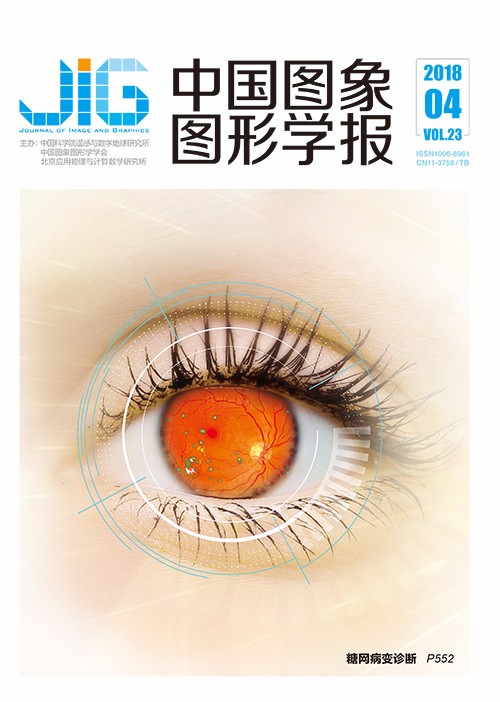
基于雾天图像降质模型的优化去雾方法
王平1,2, 张云峰1,2, 包芳勋3, 杜宏伟1,2, 张彩明4(1.山东财经大学计算机科学与技术学院, 济南 250014;2.山东省数字媒体技术重点实验室, 济南 250014;3.山东大学数学学院, 济南 250100;4.山东大学计算机科学与技术学院, 济南 250101) 摘 要
目的 图像去雾是计算机视觉的重要研究方向,既获得高质量的去雾图像,又保证较低的时间复杂度一直是图像去雾面临的挑战,为此提出了一种基于雾天图像降质模型的优化去雾方法。方法 根据雾天图像降质模型,暗原色作为先验知识,对模型的两个物理量大气光值和透射率进行优化。传统优化算法中通常都是固定其一,优化另一个物理量,与传统方法不同,考虑到大气光和透射率的相关性,采用多元优化策略,将这两个物理量作为互相影响的整体,利用迭代算法进行优化。为保持去雾图像颜色真实、自然,基于对无雾图像的统计特性,多阈值融合的约束条件作为迭代停止的条件,控制优化去雾程度,复原高质量去雾图像。结果 本文方法与其他去雾方法相比,在视觉效果上,图像结构更加清晰,细节更加丰富,色彩更加真实。在客观数据方面,本文方法获得图像的彩色直方图与有雾图像的彩色直方图在形状上更相似,同时在Cones、Herzeliya、House、Dolls对比图像中,本文方法结果图像的信息熵值都比较高,分别为13.801 270、15.490 912、15.395 014、16.276 838,且时间复杂度较He方法(使用软抠图算法优化透射率)降低了3~5倍。结论 本文去雾方法利用迭代算法对大气光和透射率进行多元优化,同时采用多阈值融合约束条件控制优化去雾程度。本文方法在色彩保真度、细节恢复等方面都优于经典算法,同时获得了较好的客观评价数据。实验结果表明,本文方法能够达到主客观都满意的效果。
关键词
Multivariate optimized haze removal method based on hazy image degradation model
Wang Ping1,2, Zhang Yunfeng1,2, Bao Fangxun3, Du Hongwei1,2, Zhang Caiming4(1.School of Computer Science & Technology, Shandong University of Finance and Economics, Jinan 250014, China;2.Shandong Provincial Key Laboratory of Digital Media Technology, Jinan 250014, China;3.School of Mathematics, Shandong University, Jinan 250100, China;4.School of Computer Science & Technology, Shandong University, Jinan 250101, China) Abstract
Objective Hazy or foggy images have low visibility, contrast, and saturation. These features are undesired in computer vision applications, such as most automatic systems for surveillance, intelligent vehicles, and outdoor object recognition. Thus, image haze removal plays a significant role in computer vision. Many haze removal methods, including image enhancement and restoration methods, have been proposed. Image enhancement methods often suffer from information loss, over-enhancement, distorted colors, and significant halos. Image restoration methods are based on hazy image degradation models and therefore perform better than enhancement methods. On the basis of image degradation models, the use of dark channels prior to obtaining haze-free images is accepted, but the restored images often suffer from the block effect. Some optimization methods are proposed to eliminate the block effect. Visual effects are improved, but the time complexity is high. Thus, maintaining the high quality of haze-free images while ensuring low time complexity has always been a challenge for image defogging. We accordingly propose a multivariate-optimized haze removal method based on hazy image degradation model. Method Unlike traditional optimization methods that fix other physical quantities while optimizing a physical quantity, the proposed method considers the correlation between the atmospheric light and transmission mentioned in the degradation model. The atmospheric light and transmission are treated as a whole, and we present a multivariate-optimized haze removal method by iteration. The multivariate-optimized haze removal method can optimize atmospheric light and transmission at the same time. Iterated dehazing is an optimization process that can continuously ensure haze-free images. We provide constraint conditions for multi-threshold fusion on the basis of the statistical characteristics of haze-free images to keep the restored image real and natural. The constraint conditions are utilized to control dehazing degree, and haze-free images are then obtained. Result Haze removal experiments on images show that the performances of the proposed method in terms of visual effect, color histogram, information entropy, and time complexity are better than those of other classical dehazing algorithms. In the subjective aspect, unlike other fog removal methods, the proposed method obtains more natural and real images. The proposed method can keep considerable image details and structure without color distortion. The halo effect and artifacts are considerably reduced in the images by the proposed algorithm. The intensity of restored images is highly preserved. In the objective aspect, the color histogram in hazy images presents a convergent distribution, and the color intensity is high because of fog cover. After removing haze, the color histogram becomes evenly distributed, and the color intensity is enhanced. Thus, the color histogram of dehazed images should be similar to the color histogram of hazy images with a structural shape. The color histograms of our resultant image and the haze image are highly similar in shape. The image information entropy of the result image is relatively high. For images of Cones, Herzeliya, House, and Dolls, the image information entropies are 13.801 270, 15.490 912, 15.395 014, and 16.276 838, respectively. We also evaluate the time complexity of our algorithm. Our method is three times to five times faster than haze removal methods that optimize transmission via soft matting. Conclusion This paper presents a multivariate-optimized haze removal method based on the hazy image degradation model. The proposed method not only can optimize multiple variables but also can achieve low time complexity. Constraint conditions for multi-threshold fusion on the basis of the statistical characteristics of haze-free images are developed to control iteration numbers, which contribute to the robustness of the method. Extensive experiments show that the proposed method can obtain satisfactory results in both objective and subjective aspects.
Keywords
single image dehazing dark channel prior multivariate optimization multi threshold fusion image restoration
|



 中国图象图形学报 │ 京ICP备05080539号-4 │ 本系统由
中国图象图形学报 │ 京ICP备05080539号-4 │ 本系统由